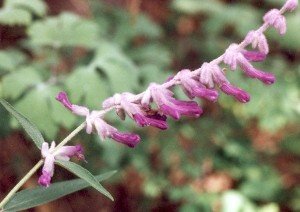Other Salvias
by Valerie (November 13, 2002)
Because of the large number of salvia plants, I've divided them into separate essays according to blossom color. Red and blue salvias, or sages, were covered previously. Here are some with lavender or pinkish colored flowers.
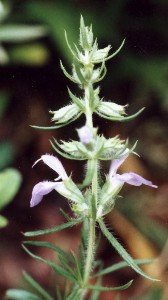
The first pictured is Engelmann's salvia (Salvia engelmannii), a native perennial wildflower in this area. Because I've added both small plants and seeds to our gardens, I'm not sure which resulted in the plant that is thriving in a hot, dry, sunny corner of one garden. Engelmann's salvia grows less than a foot tall, and sends up numerous stems, so that it forms a clump. The leaves are very stiff, narrow, and sort of hairy. The flowers, which appear in the early part of the summer, are pale, and are a bluish sort of light purple color. As we have only one plant, the seeds do not seem to germinate readily. That single plant, however, is doing very well and gets bigger every year. By coincidence, a closely related plant, blue sage (Salvia texana), grew about a foot away from the Engelmann's salvia. It had close to the same form, the flowers looked similar, although a bit darker in color, and at first I thought it was another specimen of the same species.
While the previous sage has to have sun, lyre-leaf sage (Salvia lyrata) thrives in the shade. This perennial wildflower is very easy to recognize because of its unusual leaves. They form a basal rosette, looking a bit like a dandelion or similar weed plant, but the leaves usually have dark brown or purple markings on them. The flower stems emerge from the center and produce lavender blossoms during the early part of the summer. The seeds germinate readily and the plants tend to spread. The first plant I had came up from seed, but didn't survive the hot summer due to lack of water. I thought that was the end of it, until the next spring, when there were numerous tiny plants coming up in the garden and the surrounding lawn. A popular garden plant in this area, Mexican bush sage (Salvia leucantha) is a non-native perennial. It is well adapted for sunny, dry conditions and grows to be a rather large shrub. The leaves are narrow, but several inches long and have a grainy feeling. The flowers are produced on lengthy racemes, which can grow to 6 inches long. Although they bloom more in the sun, these plants also blossom in shade. There are several color varieties available and the stems and calyxes are frequently a different color than the flowers themselves. They also have a very furry appearance and are quite soft to the touch. |
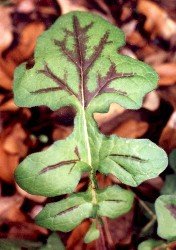 However, there were enough differences that I looked it up and found that they are indeed different species. The blue sage has slightly wider leaves with pronounced teeth on the edges, but seeing both plants next to each other was perhaps the best way to distinguish the two plants. Unfortunately, although it had a great start in the spring (possibly having started to grow unnoticed the previous year) and bloomed nicely, the blue sage didn't survive the hottest part of the summer and died by fall.
However, there were enough differences that I looked it up and found that they are indeed different species. The blue sage has slightly wider leaves with pronounced teeth on the edges, but seeing both plants next to each other was perhaps the best way to distinguish the two plants. Unfortunately, although it had a great start in the spring (possibly having started to grow unnoticed the previous year) and bloomed nicely, the blue sage didn't survive the hottest part of the summer and died by fall.
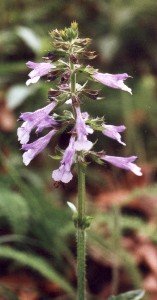
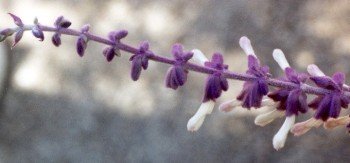 The small plants transplanted easily and now there are a number of individuals growing in the garden. The spread of the leaves is about 6 to 8 inches in diameter and the flowers grow about a foot tall. With a bit of extra water, the lyre-leaf sage survives through the heat of the summer. The plant is also called cancerweed because of medicinal properties.
The small plants transplanted easily and now there are a number of individuals growing in the garden. The spread of the leaves is about 6 to 8 inches in diameter and the flowers grow about a foot tall. With a bit of extra water, the lyre-leaf sage survives through the heat of the summer. The plant is also called cancerweed because of medicinal properties.
